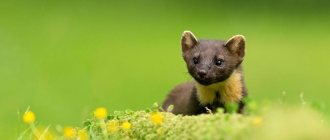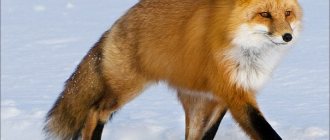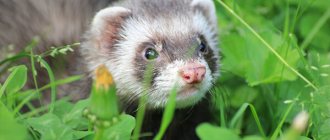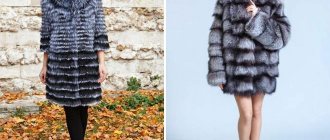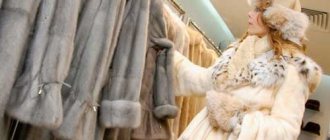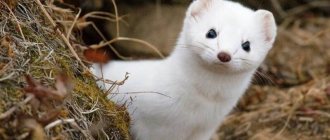Mink is a small predatory mammal from the Mustelidae family. There are 2 species - the European mink lives only in Eastern Europe. The American or eastern mink originally lived only in North America, but was brought to Europe and successfully took root. The animal is known for its beautiful, valuable fur; mink coats are especially prized.
Description and origin of the species
The European mink was first described by Swedish zoologist Carl Linnaeus in 1761, and given the scientific name Mustela lutreola.
The Latin species name Lutreola is derived from the Latin Lutra (otter) and ola (diminutive suffix) and literally means “little otter.” The Russian name “mink” was borrowed from Finnish or Estonian. According to one version, it comes from the word “nurk”, which means ermine, according to another from “nirkka”, or nirk, which translates as weasel.
The closest relatives of the European mink are the European forest ferret and the Siberian weasel. Their close relationship is confirmed by the fact that the animals easily interbreed. Despite their similar appearance, color and habits, and the common name “mink,” European and American minks are not closely related.
The North American mink was first described by German naturalist Johann Schreber in 1777, and given the scientific name Neovison vison. The American species differs from the European one at the cellular level, being closer to martens, so American mink ( Neovison) was separated into a separate genus.
The animal was introduced to Europe in the 1920s and 1930s, and successfully spread throughout the continent. The animal is gradually squeezing its European relative out of its usual habitat. The expansion of the American mink in recent decades is one of the main reasons for the extinction of the European species.
Domestic mink
Until the second half of the 19th century, there were no serious attempts to domesticate minks. Only when fur hunting ceased to satisfy the growing demand for fur did minks, along with other fur-bearing animals, become the object of fur farming. The real boom began in the 20th century in the USSR, which was accompanied by the creation of huge fur farms, where, among other things, American mink began to be bred.
Preference was given to the American mink in fur farming due to the fact that this animal produces higher quality and more beautiful fur. Today, along with Russia, mink breeding is most actively practiced in Scandinavia and Canada. And although fur farms also exist in other European countries, the volumes of fur production there are small. This is due to the fact that the highest quality and most expensive fur comes from animals raised in cold climates. Russian, Canadian and Scandinavian mink are especially valued in the world.
In the second half of the 20th century, minks began to be used as pets. Minks began to appear in apartments and private houses instead of annoying cats and dogs. Despite all the cuteness and funnyness of this animal, it has not gone through the same long path of selection and adaptation to the conditions of coexistence with humans as cats and dogs. Because of this, minks are much less amenable to training, cause a lot of trouble when kept at home, and get along very poorly with other domestic animals.
Minks tend to obey only one owner, ignoring or even being hostile to other family members, not to mention people who come to visit. Even ferrets, which are also not far from the wild state, are much more obedient and friendly pets.
However, this does not mean that minks are completely unsuitable for home keeping. If you take a puppy at as early an age as possible and put every effort into raising it from the very beginning, it may very well turn out to be a good-natured, cheerful and obedient pet mink.
What does a mink look like?
The mink has a classic appearance for the Mustelidae family - a long, flexible, squat body and short legs. Compared to its closest relative, the Siberian weasel, the mink has a more compact body and dense build; in this sense, the animal is closer to the ferret than to martens. The animal's head is relatively large and wide, when compared with other Mustelidae, this animal is also close to the ferret. The tail of the European mink is quite short, accounting for no more than 40% of the body length, while the American species has a longer tail, up to 50% of the body length.
The average body length for male European mink is 373-430 mm, for females 352-400 mm, with a tail of about 150-190 mm. The animal weighs about 550-800 grams. The American mink is noticeably larger - body length up to 50 cm, tail length up to 25 cm, weight up to 2 kg. The paws have membranes between the toes, allowing the animal to dive and swim well. When swimming, the animal pushes with all 4 legs at the same time, and can stay under water for 1-2 minutes.
Mink fur is very thick and dense, much thicker when compared with other representatives of the Mustelidae family, but it is relatively short. The American species has much thicker, longer and softer fur, which is why it is raised on farms more than other fur-bearing animals. Since the animal is a waterfowl, there is practically no difference in length between the hair on the back and on the belly. Summer fur is slightly less dense and slightly shorter, although the difference between summer and winter fur is much less than that of land representatives of the Mustelidae family.
The color varies from reddish-brown to dark brown and even almost black. The color of the animal is uniform, although some individuals have lighter fur on the belly than on the outer parts of the body. In summer, the fur color changes to lighter with a pronounced reddish tint. The European mink has white markings on its upper lip and chin, and patches of white fur are also found on the chest and throat of some individuals. The American mink has white markings only on its lower lip.
Kinds
Among the approximately fifty million minks living in various territories, there are four main species. They are called European, American, Russian and Scandinavian.
European mink can be seen near bodies of water in Eastern Europe and in areas of Siberia. She actually spends most of her life in water, this can be judged by the appearance of the mink in the photo ; it has a slightly flattened head and well-developed membranes between the toes. The European mink has short hairs, which make its dark brown or gray fur smooth and shiny.
The American mink from North America differs significantly from the European mink in its dimensions; it is longer and heavier, and also has a distinctive mark in the form of a light spot below the lip. Natural coat color can range from black to white. An ideal white mink will most likely be American.
This variety of furry babies became a real treasure for scientists who sought to develop new and diverse varieties, because only the American mink has special mutating genes that have a direct impact on the shade of its fur.
If the European mink was native to Eurasia, the American mink was brought to the continent much later for the purpose of breeding in nature reserves. Then, in order to adapt to the wild animal world, the animals began to be released into freedom, and such proximity had a detrimental effect on the European mink.
The total number of individuals of this species began to decline; the predator of the American species was rapidly encroaching on the European one. It should be noted that American and European minks, despite their similar appearance, originated from different ancestors. Identical living conditions helped the animals acquire significant similarities, but due to species rivalry, since 1996 the European mink has been listed as a Red Book animal .
The ancestor of the Russian mink was the North American mink; it was on its basis that fur farmers developed this luxurious species in the 30s of the 20th century. The “coat” of the Russian mink is distinguished by relatively long hairs and high undercoat, and the color ranges from brown to black.
Northern Europe is considered to be the homeland of the Scandinavian mink, but today individuals of this species are distributed everywhere and are the most common fur-bearing animals (about 80%) among all representatives of these animals. This is a brown mink with a rich, pronounced color and perfectly smooth, equal length, soft hairs.
Where does the mink live?
Back in the 19th century, the habitat of the European species of animal extended throughout Europe, from northern Spain in the west to the Ob River in the east, and from Arkhangelsk in the north to the northern Caucasus in the south. Over the past 2 centuries, the animal was exterminated by people or squeezed out by the American mink from more than 90% of its former territory.
Now the animal can be found mainly in Eastern Europe:
- Latvia
- Estonia
- Belarus
- Ukraine
- northwest and central regions of the European part of Russia
- Danube Delta in Romania
- northwestern Bulgaria
There are also small, isolated populations in northern Spain and western France. In the Vologda, Tver and Arkhangelsk regions, the animal is on the verge of extinction. The most stable and largest population is located in the Danube Delta - about 1,000 individuals; in Russia, the largest number of animals live in the Central Forest Biosphere Reserve in the Tver region. The animal is found at altitudes of up to 1120 meters at sea level.
The American mink originally lived only in North America; from the beginning of the 20th century, the animal was imported and successfully took root throughout Europe, Siberia, the Far East and Japan. Some individuals have escaped from farms and formed small wild populations in Chile, Argentina and South Africa.
As a habitat, the predator prefers small, remote flowing rivers and streams, with gentle banks overgrown with grass and trees. It is practically not found on large deep rivers; instead, it settles in their tributaries, headwaters, oxbow lakes and estuaries. It also lives in thickets of reeds and reeds on the shores of lakes, ponds, and less often in swamps.
Appearance
With its small size and beautiful appearance, this animal does not give the impression of a predator, although in fact it belongs to the species of predatory mammals.
This is what a mink looks like:
- the size of the body is small, no more than half a meter in length;
- elongated body shape;
- tail from 15 to 18 centimeters;
- the muzzle is narrowed downwards;
- ears are small;
- bead-shaped eyes, endowed with expressiveness and liveliness;
- legs are short, covered in thick fur, with membranes between the toes;
- weight from one and a half to three kilograms;
- short, smooth, dense fur;
- The color is almost uniform.
What does a mink eat?
Mink feeds on small animals that live in water and coastal areas. The animal's diet includes:
- mouse-like rodents, mainly mice and water rats;
- crustaceans and molluscs;
- frogs, tadpoles and eggs;
- aquatic insects;
- fish - salmon, pike, gudgeon, roach, tench, perch, brown trout, eel, and others;
- birds - gulls, ducks, cormorants, moorhens, coots;
- hares and rabbits.
The American mink's diet is dominated by small mammals, especially rabbits, followed by fish and birds, most commonly moorhens and coots. The European mink feeds mainly on smaller prey - water rats, frogs, crayfish and fish weighing up to 1-1.2 kg. Unlike its more powerful American relative, the European mink rarely catches birds and practically does not hunt hares and rabbits.
The animal eats approximately 140-180 grams of animal food per day. During periods of abundance and before cold weather, the animal makes reserves for the future, depositing carcasses of frogs, fish, and small rodents in a burrow. Unlike the ferret, the mink disdains carrion and eats it only in extreme cases, after 3-4 days of fasting. The animal carries poultry, and often steals fish from fishermen when possible.
Nutrition
The mink's diet is based on small river fish. Since the animal often obtains food for itself through fishing, its prey includes perches, tench, minnows, and gobies. The fur-bearing animal is not averse to feasting on other small animals located near bodies of water: mollusks, frogs, crayfish or river rats. Thanks to its dexterity and resourcefulness, a mink is able to wait and catch a wild bird, a young squirrel or a muskrat.
In the cold season, when hunting turns out to be unfruitful, European-type minks are supported by tree roots, wild lingonberries and rowan berries, and seeds found. As winter approaches, the animals stock up on fish and berries, storing them in their homes. The American mink prefers to eat crayfish; for it this delicacy is tastier than fish.
It is worth noting that the mink is not capable of causing much damage to fisheries, because it feeds on non-commercial fish species. In winter, these predatory mammals have to hunt exclusively on land, as the bodies of water that were previously their hunting grounds freeze.
As a result, minks kill mice and other rodents more actively in winter than in summer. Thus, the mink takes care of the environment and regulates the number of small rodents that harm nature. An average mink needs only 200 grams of food per day to satisfy its hunger.
She can divide this amount of food into 4-9 meals per day. If the available food is more than this norm, then the enterprising animal will leave reserves in its hole. The mink can be considered a very whimsical animal; it prefers to feast on fresh animals, and will only touch rotten meat after 3-4 days of hunger. Therefore, the predator regularly updates its reserves so as not to encounter this problem.
If we talk about minks living in captivity, they are usually fed fish, and sometimes grains, vegetables and even dairy products. On fur farms and farms, they carefully monitor the balance of the animals’ diet, because the quality of mink fur .
Character and lifestyle
Each animal lives in its own territory, but the size of the hunting areas is not too large compared to other representatives of the Mustelidae family, probably because there is more prey in the water than on land. The average territory of the animal is approximately 12-14 hectares; individual individuals occupy up to 60-100 hectares. Along the banks of a river or reservoir, one predator usually accounts for from 250 to 2500 meters of coastline.
The mink has one permanent den and several temporary shelters. It digs burrows on its own, preferring reed beds, old water rat holes or natural depressions. The main hole is used all year round, except during floods, and is located 6-10 meters from the water's edge.
The design of the den is quite simple, and usually consists of one or two passages with a diameter of 8-10 cm, and a length of up to 1.5 meters, leading to a nest measuring approximately 48x55 cm. The floor of the den is lined with dry grass, the hair of prey animals, moss and bird feathers. The European mink leads a more sedentary lifestyle than the American mink, and often sits out the cold in the den.
The animal is active mainly at dusk and at night, but can go hunting during the day. It searches for prey from the shore, walking about 1 km per day in summer, and about 2 km in winter. In the cold season, it prefers to move along trenches dug in the snow and rarely rises to the surface.
The animal swims beautifully, rowing with all its paws at the same time, and in case of danger it dives under the water and swims away 10-20 meters. Copes well with the current. It often hides in aquatic vegetation, holding only its muzzle above the water, and can walk along the bottom. The animal is agile and quite fast. The European mink does not climb trees well, unlike the American mink, which does not experience such difficulties.
Description
The European norm is a rather small animal. Males sometimes grow up to 40 cm with a weight of 750 g, and females are even smaller - weighing about half a kilogram and a little more than 25 cm long. The body is elongated, the limbs are short. The tail is not fluffy, 10-15 cm long.
The muzzle is narrow, slightly flattened, with small round ears, almost hidden in thick fur, and quick eyes. The mink's toes are webbed, this is especially noticeable on the hind limbs.
The fur is thick, dense, not long, with a good down, which remains dry even after prolonged water procedures. The color is uniform, from light to dark brown, rarely black. There is a white spot on the chin and chest.
Types of mink
As of 2005, 7 subspecies of European mink were officially recognized.
- northern mink M. l.
lutreola. It lives in Finland and in the north of the European part of Russia. - French mink M. l.
biedermanni. Lives in France. - M.l. binominata
- Central European mink M. l.
cylipena. A large subspecies that lives in the Kaliningrad region, Latvia, Lithuania, Hungary and Romania. - Central Russian mink M. l.
novikovi. The animal is medium-sized, slightly larger than the northern mink, while the fur is coarser, shorter and less dense. Lives in Estonia, Latvia, Ukraine, Belarus, and in the south of the European part of Russia. - Carpathian mink Mustela l.
transsylvanica. The smallest subspecies in size, lives in the Balkans, Romania, Moldova, Bulgaria, Hungary. - Caucasian mink M. l.
turovi. Large subspecies with long fur and sparse undercoat. It is found in the Caucasus, in the lower reaches of the Volga and Don, and in eastern Ukraine.
In the wild, minks sometimes interbreed with ferrets, resulting in hybrids called honoriki. These animals are more ferret-like in appearance and habits, and travel further from the shoreline than purebred minks, although they retain the ability to swim well.
The American mink currently has 15 subspecies, depending on the animal's habitat in North America. Given the expanding habitat of the animal, there will likely be more subspecies in the future.
Varieties of fur minks
In fur farms in Russia and other fur-bearing countries, only American mink is bred, as it produces larger pelts with better quality fur. There are several main varieties of this animal:
- Silver-blue mink. The most common type of mink bred in captivity. Its population is about 40% of the world's population (not counting wild minks).
- Dark brown mink. In second place in terms of numbers. It makes up about a third of the world's population. All other mink color groups were developed based on mutations and crosses of this group.
- Black mink or jet. A dominant mutation bred in Canada in the 60s of the last century.
- Sapphire mink. Hybrid of Aleutian and silver-blue mink. It has a “blue” smoky color.
- Pastel mink. Its color resembles a brown mink, but its fur is blue and generally more beautiful.
- White mink. A very rare species of mink farmed in North America. Produces extremely valuable white fur.
Reproduction and young
During the mating season, the genitals of the female European mink enlarge and change color to mauve. This animal differs significantly from the American mink, whose genitals do not change in any way during the period of estrus. During the rut, males fight for the right to mate with a female, but subsequently do not take any part in the fate of the offspring.
The mating season lasts from February to April, and the American mink always gives birth a month earlier. European mink cubs are born in April-May after 40-43 days of gestation. The American mink, like the skunk, has a unique feature - a short delay in embryo development after conception. Pregnancy of the American species lasts up to 75 days, of which the actual development of the fetus takes only 1 month. The fertilized egg does not enter the uterus immediately, but after a pause of 8 to 45 days, allowing the female to choose the best conditions for the development of the fetus.
One litter usually contains from 3 to 7 cubs, sometimes from different fathers. The puppies are born blind and weigh just 6.5 grams at birth; their weight triples in just 10 days. The eyes open after a month. At 20-25 days, European mink cubs begin to eat solid food, although the mother continues to feed them breast milk until 2-2.5 months. American minks develop faster and feed on their mother's milk for up to 5 weeks.
At the age of 56-70 days, the puppies accompany their mother on the hunt. On days 70-84, young minks become independent and leave their mother. Sexual maturity occurs at the age of 10 months, in time for the next mating season.
Mink as a fur-bearing animal
Mink is one of the most valuable fur-bearing animals bred in captivity. It “supplies” the lion’s share of the fur used in clothing and other fur products. Everyone has heard the expression “mink coat” and “Pyatigorsk mink”. This is just about these animals.
Today, according to various sources, minks provide about 70-80% of the world's demand for fur. Such a large market share is explained by the fact that among all fur-bearing animals, mink reproduces best in captivity. The creation of a mink fur farm is fundamentally not much different from the organization of any other agricultural enterprise in the livestock industry. Here, the main task of the entrepreneur is still the same - to create normal conditions for animals in cages, provide food, ensure communication between father and mother of minks for the production of children, establish a system for slaughtering animals and marketing finished products. There are no problems with the latter, since the demand for fur is very high.
The main feature and difference between the mink and other farm animals is that they are not herbivores, but predators. So you need to feed them not grain and grass, but meat. Also, an entrepreneur who wants to open a fur farm should keep in mind that the commercial characteristics of skins (fur) are directly related to the climatic zone in which the animals grew up. The further north you go, the thicker and warmer the fur the animals acquire. Accordingly, a mink farm located in the Arkhangelsk or Murmansk region will always be more profitable than a farm near Rostov or Astrakhan.
Natural enemies
The European mink is hunted by the European tree ferret, American mink, red fox, golden eagle and great owl. Foxes generally hunt all representatives of the Mustelidae family, and actively breed in places where there are few wolves and lynxes. Therefore, the more foxes in the region, the fewer minks.
The American mink is a larger and more aggressive animal, so it is less likely to become prey to predators. However, the animal is subject to strong competition from the otter - the animals often live in the same places, which is why the American mink is forced to feed on land mammals more often, yielding fish to the otter.
Natural enemies of minks
Photo: Mink animal
Natural enemies of minks include:
- Predatory mammal animals. A small animal can be killed and eaten by all predators that are larger and stronger than it. These include lynxes, foxes, bears, and wolves. But most often the mink becomes a victim of the river otter. The otter swims better and lives next to minks, so they are cleverly caught at night and during the day. Otters can dine not only on an adult individual, but also on its offspring;
- Birds of prey. Mainly the enemies are large birds: owls, eagle owls, hawks. When an animal hunts mice at night, an eagle owl or an owl can catch it, and during the day a hawk can lie in wait for a mink;
- American mink. Minks have interspecific competition. As zoologists have found out, the American species is deliberately destroying the European one in order to free up territory for itself and its relatives. However, the appearance of an overseas guest made it possible to shift the attention of hunters from the European mink;
- Human. The most dangerous enemy that intentionally, and sometimes unintentionally, destroys these animals. Today, the only thing that saves minks from death is that they began to be raised on special farms for fur.
Interesting fact: According to biologists, minks do not often become victims of predators. The main factors leading to the death of animals are hunger, disease and parasites.
European mink population
The European mink population is rapidly declining. According to scientists, the number of animals in the wild has decreased by 50% over the past 3 generations, and continues to decline. The decline in mink numbers in Europe began in the 18th century, when the animals disappeared from Germany, Austria and Switzerland. At the beginning of the 20th century, the animals became extinct in the Czech Republic, Poland, Bulgaria and Hungary. In Latvia, Finland and Lithuania, minks were considered extinct, but a few individuals were spotted in the 1990s. In Estonia, Belarus, Moldova and Ukraine, as well as Spain and France, by this time only small fragmented populations remained. In the European part of Russia, mink was found everywhere at the beginning of the 20th century, but the number of animals began to decline rapidly in the 1950-1960s.
The most likely reasons for the decline in the number of European mink:
- reduction of natural habitat due to river drainage and agricultural land expansion. This happened throughout the 19th - 20th centuries throughout Europe - in Germany, Russia, Moldova, Ukraine, Poland, Hungary, the Baltic countries, and others.
- excessive hunting of animals for their valuable fur, especially in Russia. At the beginning of the 20th century, 40-60,000 skins were mined per year in Russia, and about 3,000 in Finland.
- a sharp decline in the number of broad-toed crayfish . These crayfish were almost completely destroyed in Europe due to the crayfish plague.
- stiff competition from American mink. American mink was brought to Europe in 1920-1930. The American species is 20-40% larger than the European species, reproduces a month earlier, and is also not so strongly attached to the shores of reservoirs, so it is easier to adapt to changed living conditions. The number of European minks was falling even before the arrival of American minks, but fierce competition for resources and diseases brought from America accelerated the decline in the population.
Hunting and fishing
Fishing activities in relation to the American mink species do not need to be limited, since the number of its European counterpart has noticeably decreased. In order to somehow increase the number of valuable animals, it would be useful to carry out appropriate measures to resettle the mink. This will, in turn, help increase hunting opportunities for hunters and fishers.
Protection of the European mink species
The animal is included in the international IUCN Red List as a species on the verge of complete destruction. In Russia, it is included in the Red Book of the Russian Federation and in the Red Books of a number of subjects of the Federation - Bashkiria, Udmurtia, Komi, Yamalo-Nenets Autonomous Okrug, Perm Territory, Novgorod, Pskov, Chelyabinsk, Sverdlovsk, Orenburg, Tyumen and Sakhalin regions.
The mink is protected in all countries within its habitat. Genome conservation programs are being implemented in Estonia, Spain, France, Germany, and Romania. In Russia, in the 1980s, more than 300 individuals of the European species were brought to the Kuril Islands of Kunashir and Iturup, in an attempt to save the population from the American mink, but it was not possible to obtain a stable population there.
Mink: care and maintenance of a pet
Both European and American mink can be kept as a pet. However, due to the fact that the “European” is a rarer species and is even listed in the Red Book, American minks are still more common.
By and large, caring for and maintaining a mink in an apartment is not much different from keeping a ferret. The only difference is that minks are very freedom-loving and perceive being kept in a cage extremely negatively. This animal is quite easy to train to a tray, and it is not at all picky about food. Typically, mink are fed mixtures of rice or buckwheat porridge and minced meat. Any meat will do: poultry, fish, beef, pork. You can also use ready-made cat food.
Since minks have a fairly fast metabolism, they are mobile and active. The Internet is full of videos of minks frolicking and mischievous. This is a really funny and cheerful animal, so to minimize damage to the apartment you need to equip a small “playground” for the animal in the apartment. It is also highly advisable to regularly take the animal for a walk.
At the same time, you need to be prepared for the fact that while you are not at home, your pet will independently arrange your things there and in the form in which it is convenient for him. Sharp claws and a flexible body allow the mink to climb anywhere, including places from which it can no longer get out. So, during your absence, it is better to lock the animal in a spacious cage or enclosure.
Minks have a great passion for water, so you need to provide the animal with at least an imitation of a reservoir - a basin or a small personal bath. The mink will be very grateful to you for this pleasure.
Like ferrets, minks have a noticeable, specific odor. It is impossible to completely get rid of it, but by regularly cleaning the “nest”, it can be significantly reduced. To maintain the health of a domestic mink, it must be periodically vaccinated (especially if the mink often walks outside) and dewormed.
Classification of mink skins by size
According to the standards of the Russian Federation, skins are classified into two sizes, length and width. The length is measured from the midline of the eyes to the base of the tail, and the width is measured along the central axis of the skin and is divided into two, that is, when indicating the width of the mink skin, only half of it is actually indicated. The gender of the mink is also taken into account, since the males of this animal are, as a rule, much longer than the females and have thicker fur. Females are smaller, with thinner flesh.
The skins of males are most often longer than the skins of females
But the classification remains the same for both males and females. There are five size categories for mink skins:
- Particularly large A - length over 70 centimeters, width over 7.5 centimeters.
- Particularly large B - length 65-69.9 centimeters, width not less than 7 centimeters.
- Large - length 54-64.9 centimeters, width not less than 6.5 centimeters.
- Medium - length 47-53.9 centimeters, width not less than 6 centimeters.
- Small - length 40-46.9 centimeters, width not less than 5 centimeters.
Mink skin size categories
Mink lifestyle
European minks are nocturnal and very secretive.
They live in shallow burrows, the simplest of structures, with one entrance. Often the entrance hole is hidden from human eyes under water. Sometimes animals make their nests in hollows of fallen trees or in crevices between roots. The bedding in the nest is made from the skins of voles and water rats, grass and feathers. In addition to the main hole, the prudent mink also has several temporary shelters.
In late autumn, the animals lead a nomadic lifestyle, traveling along small rivers. In winter, they stay near rapids, riffles and polynyas.
Mink molting is slow and gradual. It begins in March, lasts all summer, gradually turning into autumn, which ends only in December.
Minks are solitary, with the exception of the mating season in spring. Both males and females can mate with multiple individuals, but females raise their young alone.
Nutrition
Minks are carnivores. Their main food is small mouse-like rodents, water rats, fish, frogs, freshwater mollusks, crayfish, and in some places crabs. In some areas, European minks settle near rivers that are completely devoid of fish. Then rodents become their main food.
Reproduction
The breeding season for these animals is from February to the first half of March.
Pregnancy lasts 40-65 days, and according to some sources – up to 72 days. The extended period of pregnancy is explained by the presence of a latent period in the development of the egg in some females.
Most often, 4-5 cubs are born, with a maximum of 17. Newborns are covered with white fur-down. They weigh about 7 g. On the 30th day from birth, they open their eyes. The cubs feed on mother's milk for about two months and by mid-July they reach half the size of an adult female.
Lifestyle of European and American mink
Nature itself made the mink an ideal hunter. She can eat anyone who is smaller in size, even on the shore, even in the water. The animal has a highly muscular, long and slender body. Despite the short legs, the mink swims well, runs quite quickly on land and climbs well (American species). These animals grow up to 40-50 cm in length, and therefore their prey is not only river fish, frogs and small rodents, but also rabbits and even muskrats.
Thanks to the streamlined body shape, movable long tail and small membranes on the paws, the mink swims excellently (can stay under water for up to 2 minutes), its favorite pastime is fishing. These predators from the mustelid family have small eyes and poor vision, so when hunting they rely more on their sense of smell. This hunting sense allows the mink to go out hunting in the dark. The predator reacts quickly to moving objects, much less to stationary ones.
Fur-bearing animals settle close to natural bodies of water, since their main prey is found in water. Animals choose areas near the banks of shallow rivers and streams, establish permanent and temporary shelters near ice-free lakes and swamps with dry banks overgrown with grass or low bushes. Minks rarely move further than 250 m from bodies of water.
The European species more often builds its own multi-chamber dwelling with several passages. The animals line the main chamber of the burrow with dry leaves, grass, moss, and bird feathers. The toilet is located next to the shelter.
American minks prefer to occupy the deep, winding burrows of other animals; they rarely set up their own homes. Predators defend their territory and, if necessary, will repel any invader. The main weapon for attack and defense is sharp teeth. Also, in case of danger, minks secrete a secretion from the anal glands with a strong unpleasant odor.
Small predators from the mustelid family are nocturnal, but sometimes hunt during the day. The animals are most active in the spring (during the rut) and autumn (associated with the resettlement of young animals and the search for more favorable reservoirs for life). Minks spend most of their time on land; in winter, when polynyas form, they can move along them without appearing on the surface for a long period.
Mink after hunting
Minks lead a solitary lifestyle, prefer quiet, secluded places, and try not to be seen by people. It is rare to see animals, most often while fishing, in the evening or early in the morning. The presence of a mink in a pond will be revealed by the traces left behind. Paw prints are similar to those of a ferret, but those of a mink are round and larger. The predators' paths are repeated day after day, and burrowing sites are specially marked with scent marks.
The period of active breeding of minks begins in early spring and can last until May. Females give birth to their first litter in April.
Molting in fur-bearing animals occurs gradually, beginning in spring and ending in late autumn.
The main enemy of mink in the wild is the river otter. In places where both species live, the otter has an advantage, since it is larger and swims better. Feral pets are also a danger. By smell, stray dogs find nesting shelters of minks, can tear them apart and destroy the offspring. Dogs are also dangerous to adult minks.
Nutritional Features
The fish diet of the animals is determined by the year-round availability of this food resource. The predator tries to choose ice-free bodies of water for its home. In addition, the mink is an excellent swimmer and dives deeply. There is no fish - it feeds on mollusks, small rodents (even squirrels), snakes, crayfish, frogs, birds (including domestic ones) or even insects.
The animal also travels along branches and destroys bird nests. He eats only 200 g of food per day. If the hunt brought larger prey, the predator stores supplies in its shelter.
If fishing is unsuccessful, it can temporarily feed on mushrooms, berries, roots or seeds. Near populated areas, wild individuals visit landfills and garbage dumps. But they rarely turn to carrion or missing meat, only in extreme cases.
If the hunt is unsuccessful, the mink may disrupt its nocturnal lifestyle and go hunting during the day.
When raised in a cage, a furry animal is fed fish fillets, dry or wet meat-based mixtures. Mink farming is a profitable business. Just prepare good conditions for them first.
What does a mink eat?
The diet of predators is associated with all elements of the coastal and aquatic environment. The predominance of certain types of food in the diet depends on the time of year, food availability and the diversity of local fauna.
Minks feed on almost all small animals available to them, which are found in or near bodies of water. In winter, the main part of the diet consists of small river fish (tench, gudgeon, perch), frogs and mouse-like rodents. During the snowless period, minks feed on aquatic insects, birds, and crayfish. They prefer fresh prey and only during the period of fasting, after 3-4 days they can switch to rotten meat or pick up food waste. Since American minks are larger than European ones, they often hunt larger animals, for example, muskrats, and on occasion they can run over a squirrel. Every day, these representatives of the mustelid family consume about 200 grams of food and feed from 4 to 9 times a day. If there is a lot of food, predators bring the remains to the shelter.
With the onset of cold weather, fur-bearing animals stock up on food in the form of headless/bitten water rodents and frogs, perches and minnows, and sometimes birds. Minks often replenish their reserves and take care of the freshness of the accumulated food. In winter, plant foods include tree seeds, lingonberries and rowan berries.
If animals live near populated areas, they may visit chicken coops.
Mink with prey
Population and species status
Currently, the European mink is a species on the verge of extinction and is listed in the Red Book. The main reasons for the decline in the number of this species, according to scientists, are:
- Habitat loss due to human activity.
- Hunting.
- Decrease in the number of freshwater crustaceans included in the mink’s food supply.
- Competing with the American mink and becoming infected with diseases that it carries.
- Hybridization with a ferret, which often occurs where the number of minks is already low, so it is not always possible to find a partner among representatives of their own species. The problem is that although the female hybrids can reproduce, the males, which are a cross between a ferret and a mink, are infertile, which in the long term leads to an even greater decline in the population of the species.
- Increase in the number of natural predators, especially foxes.
All this has led to the fact that European minks living in the wild are literally on the verge of extinction . Therefore, in most countries where these animals are still found, measures are being taken to preserve the gene pool and increase their population. To achieve this, along with constant monitoring of mink numbers, measures such as habitat restoration, creation of reserve populations, and even genome conservation programs are carried out, for which a number of wild-caught individuals are kept and bred in captivity in case of final extinction in their natural environment a habitat.
For centuries, people have treated the European mink only from the point of view of a consumer who is only interested in its warm, thick and beautiful fur, while completely forgetting that uncontrolled hunting and destruction of places where these animals live in the wild, as well as the later introduction of the American mink will inevitably lead to a decrease in the population size.
We realized this late, already when all that was left of the former vast habitat of the European mink were small islands where these animals were still found. The animal protection measures taken to increase the number and preserve the gene pool of the European mink, although only slightly, have improved the situation, so that this mustelid species has a chance not only to survive, but also to spread again to all its former habitats.
Return to content
